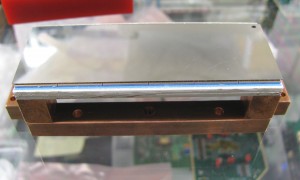
The current, most recent module of the "Helmholtz cube" that uses 3-D technology and the latest bonding techniques.
Detector specialists who have been watching and helping with the progress of the vertically integrated micro-electronics – 3-D ASIC chip for short – know that they are in for something big. Something big that’s rather small, incidentally, but that’s not the main point here – follow this link if you’d like to know more about the details of the incredible shrinking pixel sensor that could one day get us the data from the ILC detectors. Size matters aside, the point here is that the system is so versatile and has so many advantages that it can be used in all sorts of detectors (and even your mobile phone), which is why it plays a major role in a new platform organised and funded by the German Helmholtz Association of research centres on detector technologies and systems. Nine Helmholtz institutions, eleven universities and seven other research institutes from a total of seven countries (France, Germany, Great Britain, Italy, Poland, Switzerland and the US) are involved. Not all of these are particle physics institutes; in fact, they are the minority as many of the others do applied research, for example in medical studies with accelerator-based light sources.
The new platform rests on three pillars – technology, data transfer and detector prototypes. Heinz Graafsma from DESY in Germany, who develops detectors for photon science experiments, coordinates the technology pillar. “We’ve been pushing for this pillar to develop the 3-D systems further – it will come in handy for all sorts of applications,” Graafsma says. The European XFEL, for example, has inherited the bunch structure from the ILC’s planned predecessor TESLA. Conventional detectors cannot read out the results in real time, but they also cannot store all the information – which would lead to a scientist’s worst-case scenario: data would get lost. Enter the 3-D electronics: “Thanks to its vertical structure it can store all information from all bunches,” says Graafsma. A no-loss-win situation, so to speak.
Particle physicists and photon scientists have been sitting around one table to develop detector technologies and ways to transfer the data for a while, but rather unofficially and mainly at DESY. The new Helmholtz platform puts the grassroots collaboration on a more official level that also has a much wider scope, with Helmholtz centres like the Dresden institute for material, cancer and nuclear safety research (HZDR) or the Darmstadt heavy-ion research centre (GSI). The platform is subsidised by the Helmholtz Association as a so-called portfolio topic with a total of 13 million euros between 2012 and 2016. After 2016 it is planned to continue the projects developed on the platform within the scope of the Helmholtz Association’s research programme.
“There is a lot we can learn from each other, which in the end can help push the technology even further,” says DESY’s Ties Behnke, also head of the DESY ILD TPC group for which the 3-D technology could also be interesting. Particle physicists have the big collaborations and experience with solving challenging technological problems on extreme scales, photon scientists have faster turnaround and can thus gain wider and more immediate experience with the new technologies.
One planned application of the newly formed collaboration across the board is the so-called Helmholtz cube – a plug-and-detect component that uses the latest knowledge in not only 3-D ASICs but also the latest (and thinnest) bonding techniques. This Helmholtz cube is currently in the prototyping phase but will by 2013 become a component that Helmholtz researchers can just pick off the shelf, attach their specialised detector to and program it to their specific needs, go to the neutron, photon or high-energy beamline they need for their research.

Recent Comments